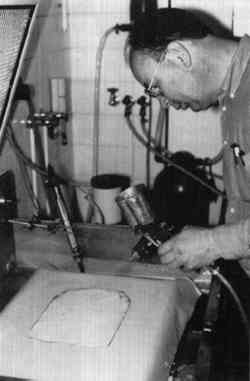OBSERVATIONS ON DEVELOPMENTS IN THE TREATMENT OF WORKS ON PAPERT. K. McCLINTOCK
4 PULP REPAIRSThe hand paper makers in America, Great Britain, and Japan have been very responsive to the needs of conservators in developing an assortment of Asian and Western-style sheets for use in mending, filling, lining, and mounting. Despite these resources, there will always be a dearth of historic or contemporary samples for repairs that achieve the perfect match of color, texture, thickness, and opacity. Paper pulp addresses that need when filling a loss, with the additional advantage that pulp often bonds better to the edges of a loss and is easier to manipulate into small locations or those reduced in thickness by skinning. The edges of tears can be fibrillated while wet to clean them and achieve better integration of mends or fills, for which a hand-held electric engraving tool fitted with a splayed bamboo stick has proved useful. Spot filling, a variation on leaf casting, is possible over a suction table, plate, or disc. If the object is intolerant of moisture, papers may also be cast in organic solvents or in small amounts to be dried and used as fill material. Templates have been made with silk-screen resist on polyester web to simulate the patterns of textured papers. The thinnest of sheets can be leaf cast, brushed with nonaqueous adhesives, dried, and applied with solvents for local reinforcement over text or image. As an alternative to lining, attempts have been made in the Netherlands to incorporate adhesives into pulp for spraying over sheets in need of very transparent reinforcement (fig. 3). Color matching has generally been achieved by mixing pulp from sheets of assorted colors or inpainting after drying. Following the lead of hand paper makers, efforts at coloring the pulp in the original furnish are being made with cationic polyamine retention agents and
|
